Northern Kyoto
The term "Kyoto North" doesn't mean a particular neighborhood, but the northern area of the city, where there are many important places, quite far from each other, but all grouped on this page.
The neighborhood
In the north-west part of Kyoto there are two of the most famous places in the city and of all Japan, along with some other temples of interest: the Golden Pavilion of Kinkakuji Temple and the rock garden of Ryoanji temple, about 1.5 km from each other.
Kinkakuji Temple
(admission 400 yen, opening hours 9:00-17:00)
This Zen Buddhist temple, officially called Rokuonji Temple, is perhaps the most famous place in the city, because of its pavilion covered in gold leaf (
Golden Pavillon), on the banks of a pond and surrounded by a traditional Japanese garden which make this place really wonderful, and one of the most photographed in the country.
The complex was founded in 1397, but all the buildings with the exception of its Golden Pavilion no longer exist.
The pavilion consists of 3 floors (12.5 meters in height), and each of the three floors is built following a different architectural style, respectively the
Shinden style, the Bukke style (the style of the old residences of the samurai) and Zen syle. The interior of the building is not open.
In addition to the pavilion and the beautiful surrounding gardens, there is virtually nothing else to see, except for the
Sekkatei Teahouse, a small building added to the complex in the Edo period (it can be visited).
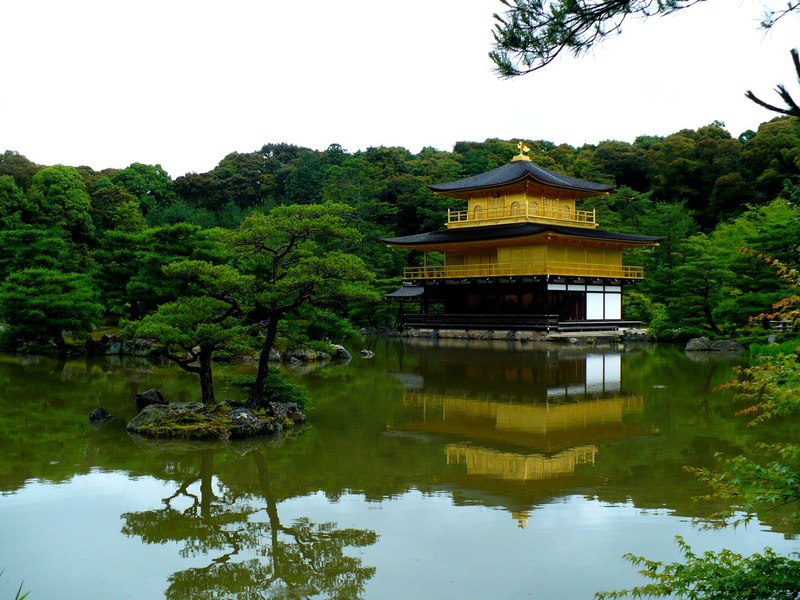 typical postcard from Kyoto: The Golden Pavilion of Kinkakuji Temple
typical postcard from Kyoto: The Golden Pavilion of Kinkakuji Temple
Ryoanji Temple
(admission 500 yen, opening hours 8-17, 8:30-16:30 dec-feb)
A Zen Buddhist temple belonging to the Rinzai sect, founded in 1450.
This temple is famous only for the rock garden inside, which occupies an area of 248mq and is considered the greatest example of
Karesansui (japanese rock garden).
The origins of this garden are rather uncertain, it is not known with precision the date of creation nor the one who conceived it. Many scholars have debated on what the arrangement of rocks wants to represent, one of the most shared opinions is that it does not represent anything concrete, but only an abstract representation from which everyone can draw inspiration for his meditation.
It is recommended to visit this place as soon as possible in the morning, before the mass of tourists reaches it, everyday a lot of people clog this place that would deserve to be visited with silence and tranquility instead.
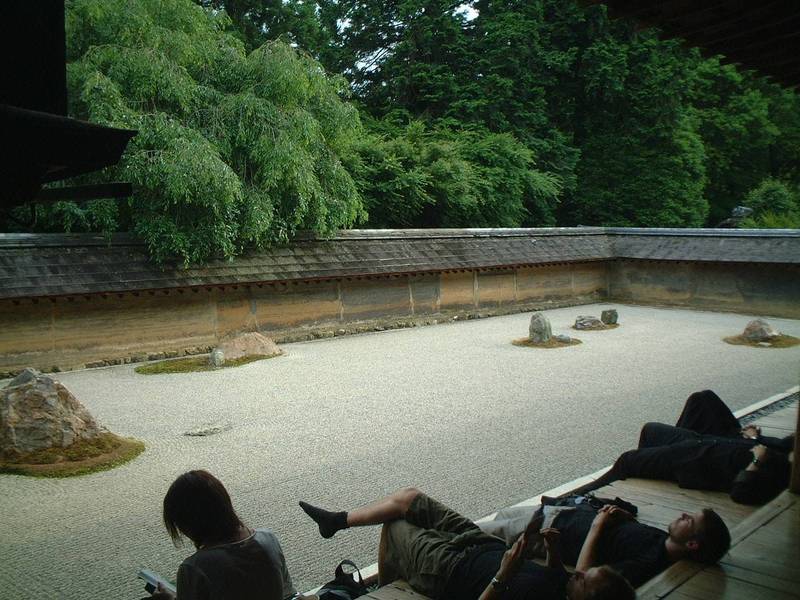 the most famous rock garden in Japan, inside the Ryoanji Temple
the most famous rock garden in Japan, inside the Ryoanji Temple
Ninnaji Temple
(free admission, opening hours 9-17, until 16:30 dec-feb)
One of the few Buddhist temples of Kyoto with free admission, the temple buildings also include a 5-story pagoda, and especially the
Goten Palace (admission charged separately, 500 YEN), the former residence of the chief priest of the temple, characterized by some of the walls adorned with elegant paintings and surrounded by a beautiful garden.
Another peculiarity of the temple is the presence of many
Omuro cherry trees, which bloom shortly after the common cherry (you may observe the flowering even in the second half of April). During the flowering period, the entrance to the whole temple is not free but it costs 500 YEN, given the exponential increase in visitors. During the rest of the year instead you can visit this place in peace and quiet, it is rarely included in tourist tours.
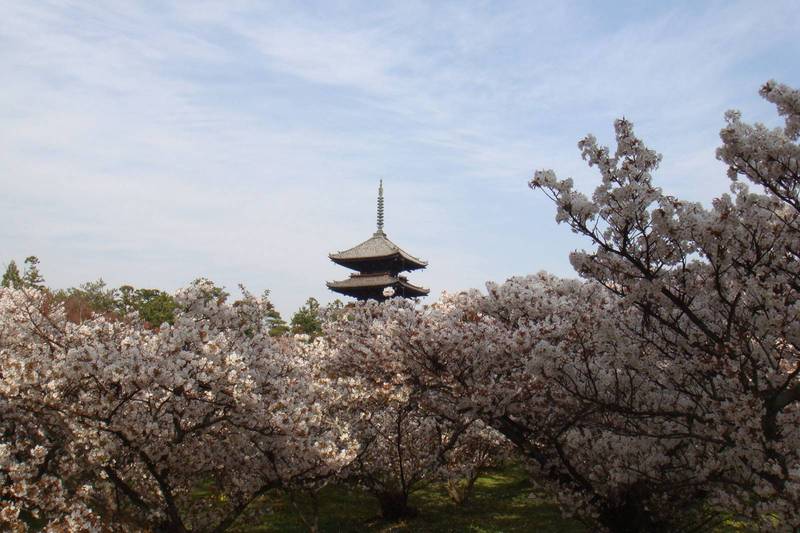 the pagoda of the Temple Ninnaji that stands among the blooming Omuro Sakura trees
the pagoda of the Temple Ninnaji that stands among the blooming Omuro Sakura trees
Kitano Tenmangu Shrine
(free admission, opening hours 5-18 apr-sept, 5:30-17:30 oct-mar)
One of the most important Shinto shrines dedicated to Sugawara Michizane, a figure linked to the culture and school in the Shinto culture, which is why these temples dedicated to him are often a place of prayer for young students looking for good luck, for example before an important exam.
Other items related to Michizane are a lot of plum trees (his favorite trees) in the grounds of the sanctuary along with maple trees, making this place really wonderful in spring and autumn.
Moreover, a flea market is held near the shrine on 25th of every month.
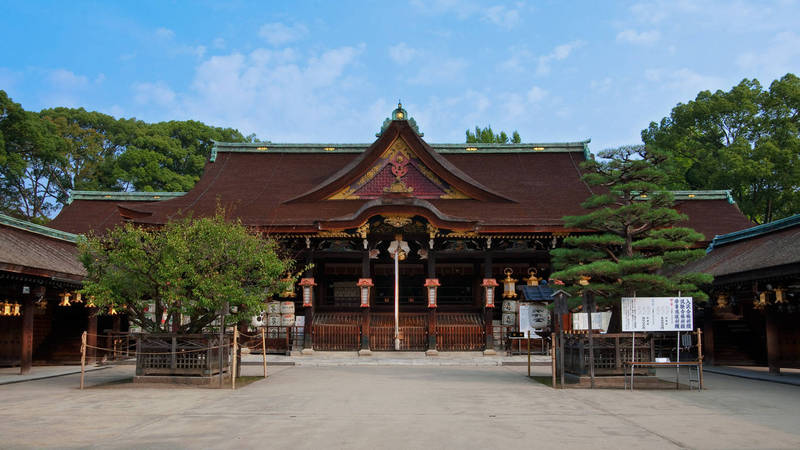 the main building of the Kitano Tenmangu Shrine
the main building of the Kitano Tenmangu Shrine
Daitokuji Temple
(admission 500 yen, opening hours: 8:30-17:30, 8:30-16:30 da sep a mar)
A huge temple complex that includes, in addition to the main temple (which in my opinion is not very interesting), other 24 small secondary temples nearby. Unfortunately, many of them can not be visited, and the few that you can visit require an additional admission fee.
The sub-temples regularly open are four:
-the
Daisenin (admission 400 YEN, opening hours 9-17), which despite being a sub-temple, is one of the most important Zen temples of the city, famous for its rock gardens considered among the best examples of such that can be admired in Kyoto;
-the
Kotoin (admission 400 YEN, opening hours 9-16), famous for its maple trees that surround the approach to the temple, and make the place even more spectacular in autumn;
-the
Ryogenin (admission 350 YEN, opening hours 9-16:30), one of the oldest in the complex, it houses inside 5 small Zen gardens, including the one that is considered the smallest rock garden in all of Japan (
Totekiko);
-the
Zuihoin (admission 400 YEN, opening hours 9-17), here you can admire another beautiful rock garden;
Other important sub-temples, but often closed to the public, are the
Jukō-in, the
Ōbai-in, the
Sōken-in, the
Shinju-an.
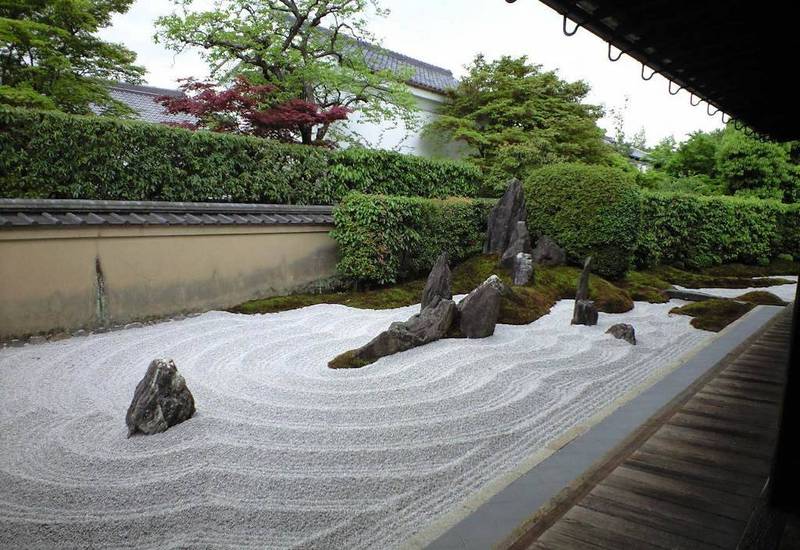
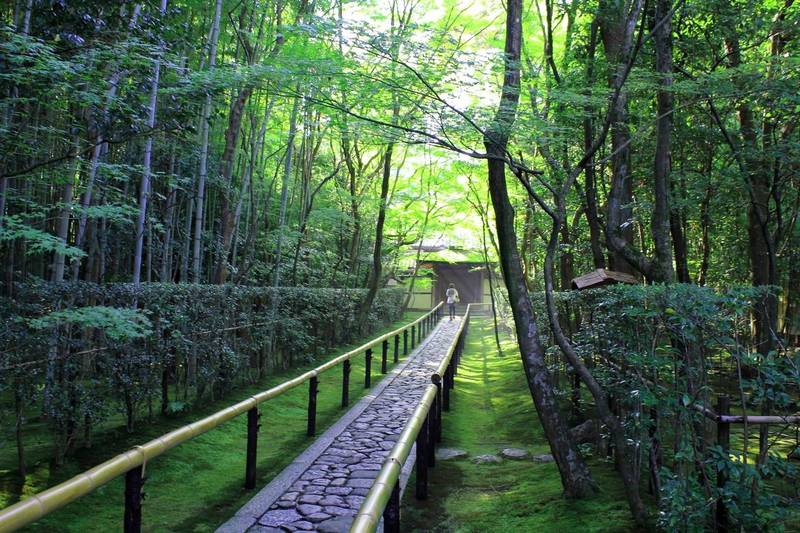 Zen gardens inside the Daisenin (on the left) and the approach to the Kotoin (on the right)
Zen gardens inside the Daisenin (on the left) and the approach to the Kotoin (on the right)
Kamo Shrines
In northern Kyoto two of the oldest and most famous Shinto shrines of the city are located, they are known as the "
Kamo Shrines", dedicated to the kami Kamo Wake-ikazuchi and belonging to the UNESCO World Heritage Sites:
-
Shimogamo Shrine (free admission, opening hours 6:30-17), ithe older of the two, founded in the sixth century, this shrine is located in the middle of a "sacred" forest, the
Tadasu no Mori, located between the rivers Kamo and Takano.
-
Kamigamo Shrine (free admission, opening hours 8-16, 8:30-16 nov-mar), founded in the seventh century, this shrine is located about 3 km further north, near the banks of the Kamo River.
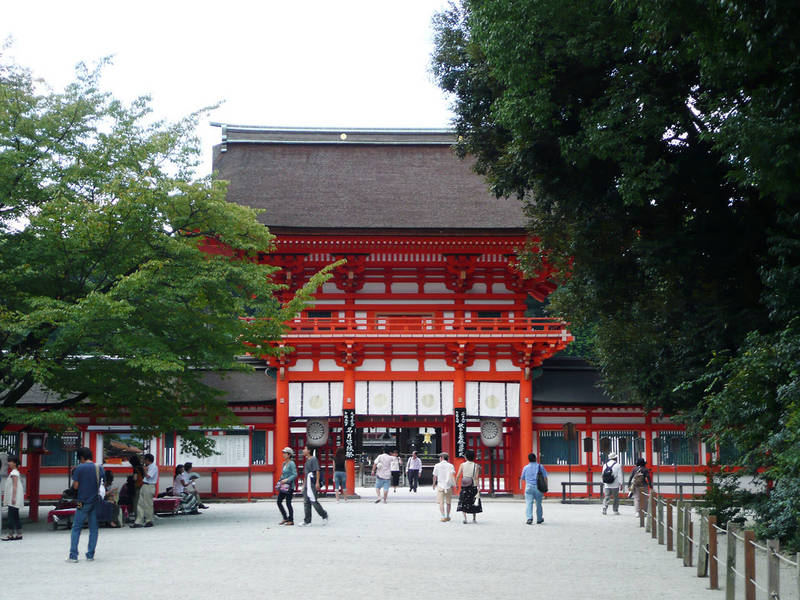
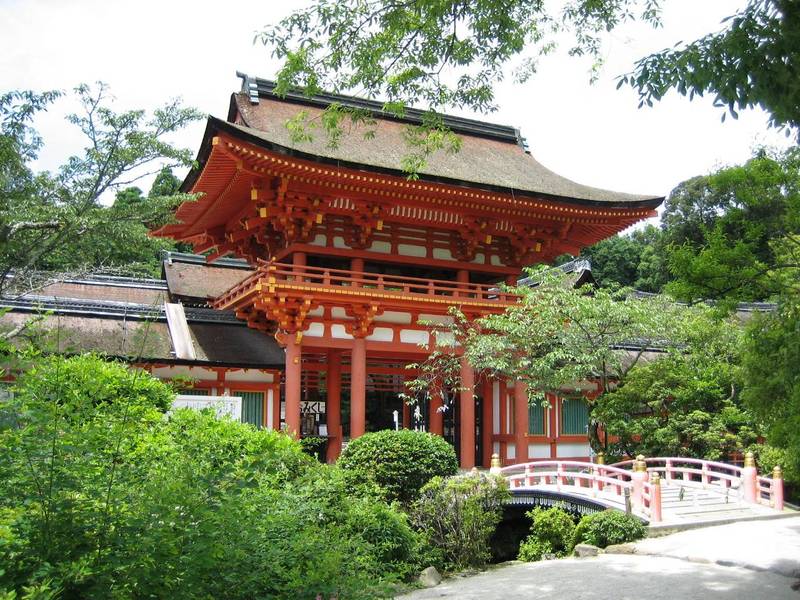 entrance to the Shimogamo (on the left) and Kamigamo (on the right) shrines
entrance to the Shimogamo (on the left) and Kamigamo (on the right) shrines
Every year, on May 15, there is one of the most famous festivals in the city, the
Aoi Matsuri, with a parade in traditional costumes that starts from the
Imperial Palace to the Kamigamo Shrine, passing through the Shimogamo Shrine. In the days before the parade,at the two shrines various events are held, if you're in Kyoto at that period, try to find out more.
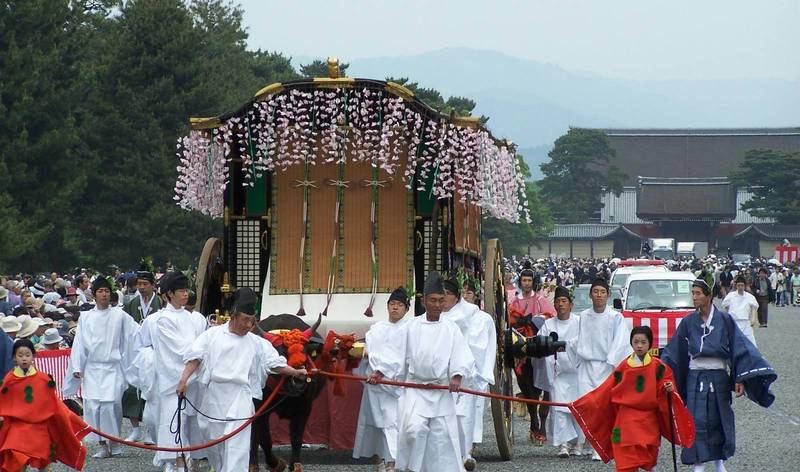 the parade of the Aoi Matsuri
the parade of the Aoi Matsuri
Exactly halfway between the shrines Kamogamo and Shimogamo, on the banks of the Kamo River, you can find the
Kyoto Botanical Garden (admission 200 YEN for outside gardens and 200 YEN for indoor gardens, opening hours 9-16), the oldest botanical garden in Japan, home to about 12,000 different trees and plants from all over the world.
Pratical guide, how to get around Northern Kyoto and map
As I have already explained at the beginning of the page, "Northern Kyoto" is a too large area, it can't be visited all on foot.
How to get to the Kinkakuji, Ryoanji and Ninnaji temples
These three temples are located in the north-west of the city, and are located within a radius of about 3 km, so if you're good walkers, once you reach one, you can visit the others too, moving on foot.
The only temple which is directly accessible from Kyoto Station is the Kinkakuji, getting off at
Kinkakuji-michi bus stop taking the line number
101 or
205 (220 YEN, 40 minutes). This bus stop is also served by lines
number 12,
102,
104, and above all by the line
number 59, through which you can get closer to the Ryoanji (getting off at
Ryoanji-mae stop) and to the Ninnaji (getting off at
Omuru-Ninnaji stop, served also by lines
10 and
26).
How to get to the Kitano Tenmangu Shrine
This shrine is located about 2 km away from Kinkakuji, but towards the south, towards an other direction than the one to the Ryoanji, so it would be very tiring to insert this place in an hypothetical walking tour together with the three temples of paragraph above.
The nearest bus station is
Kitano Tenmangu-mae, served by the line
number 50 (220 YEN, half an hour from Kyoto station) and by lines
10,
101,
102 and
203.
How to get to the Daitokuji Temple
The nearest bus station to this temple is
Daitokuji-mae, reachable from Kyoto station by lines number
101,
205 or
206 (220 YEN, 45 minutes), and served also by lines
12,
102 and
204.
Alternatively, the
Kitaoji metro station, served by the
Karasuma line, is located 1,8 km east of the temple complex.
How to get to the Kamo Shrines
The two Kamigamo and Shimogamo shrines are within 3 kilometers away of each other.
The nearest bus stops respectively are
Kamigamojinja-mae (last stop of lines number
4 and
46) and
Shimogamojinja-mae (served by lines number
4 and
205).
The nearest railway stations are instead
Demachi-Yanagi Station (
Keihan line), 1 km away from the Shimogamo Shrine, and
Kitayama station (
Karasuma line of the Kyoto Municipal Subway), 2 km away from the Kamigamo Shrine.
The
Kyoto Botanical Garden is located instead a few meters on foot from the just named
Kitayama station (
Karasuma line).
Guided tours, activities and other things to do
If you are planning a trip to Japan and you want to do something more than just visiting famous places and monuments, we suggest you to use
Rakuten Travel Experiences.
How to use Rakuten Travel Experiences
Rakuten Travel is a very useful website to
enrich your travel experience, especially if you are going solo or it's your first time in Japan.
Because of the language barrier (and more), in Japan it is very difficult to interact with the locals and to get off the tourist track.
Thanks to Rakuten Travel you can find a lot of interesting and sometimes unique
guided tours and activities all over Japan (and not only in Japan), that you would otherwise never be able to enjoy.
But there's more: on Rakuten Travel you can also
buy tickets for several famous attractions, events, transportation and other useful services for tourists. Last but not least, you can
reserve a table in hundreds of restaurants.
Some examples
Take a look at Rakuten Travel Experiences
You may also be interested in